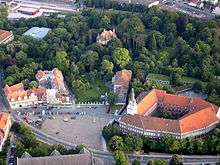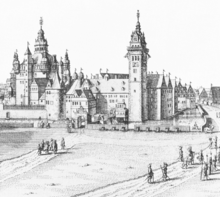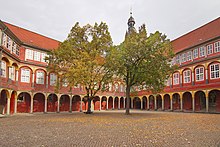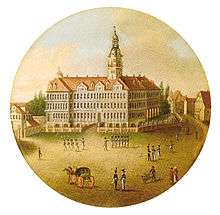Schloss Wolfenbüttel
The Schloss Wolfenbüttel is a castle in the town of Wolfenbüttel in Lower Saxony in Germany. As an extensive four-wing complex, it originated as a moated castle. It is the second-largest surviving schloss in Lower Saxony and served as the main residence for the Principality of Brunswick-Wolfenbüttel between 1432 and 1753. It is now used by a secondary school, the Federal Academy of Arts Education and a museum. In the immediate vicinity are the Herzog August Bibliothek, the Lessinghaus, the Zeughaus and the Kleine Schloss.
.jpg)

History
Middle Ages

It was first recorded in 1074 and was built as a fort on the river Oker by Widekind of Wolfenbüttel, recorded between 1089 and 1118. In the Oker marshes there was already a small settlement known as Wulferisbuttle, sited on a trade route between the Rhine and Elbe and the bishoprics of Halberstadt and Hildesheim, used by both merchants and pilgrim monks. In 1191, the castle was destroyed by duke Henry the Lion, the head of the House of Welf and brother-in-law of King Richard Lionheart. It was then rebuilt by the Wolfenbüttel lords. When Gunzelin of Wolfenbüttel refused to swear allegiance to Albert I of Brunswick in 1255, the latter destroyed the fort again, and he also chased Gunzelin's son Burchard of Asseburg from nearby Asseburg Castle, after a siege of 3 years, in 1258. Wolfenbüttel Castle was rebuilt by Henry I of Brunswick-Grubenhagen in 1283. The current plan of the castle, its moat and the lower levels and dungeon of the keep all date to Henry's time.
16th and 17th centuries
In 1350 it became the Welfs' residence in Brunswick. It was captured and destroyed in 1542 by the Schmalkaldic League and rebuilding only began in 1553 under Duke Henry the Younger, who created a new residence and converted the old tower into a castle chapel. In 1575 courtyards were added with Italianate arcades.

In 1595 the Protestant composer Michael Praetorius became private secretary to Henry Julius, Duke of Brunswick-Lüneburg - he lived in the castle and as court organist is also known to have played the castle organ, completed in 1596. Henry Julius also founded Germany's first indoor permanent theatre in the castle, with an English troupe of actors, making the town the birthplace of German theatre. The castle previously had more towers, some of whose foundations still survive. The Hausmannsturm was built in the Renaissance style in 1613 by Paul Francke - it was the castle's tallest tower and still stands today.
Duke Augustus moved to the castle in 1642 and between 1641 and 1643 also granted Conrad Buno a room there - Buno created several copperplate images of the castle.[1] It was damaged during the Thirty Years' War. Between 1690 and 1697 the castle underwent a major rebuild which converted its great halls into rooms for the dukes to live in. Between 1714 and 1716 the architect Hermann Korb added a new Baroque timber-framed facade to the castle - the stone entrance gate and the sculptures by the Austrian Franz Finck on the bridge and along the moat all also date to this period. The sculptures embody the dukes' virtues and duties.
Later life
.jpg)

The ducal court relocated to Brunswick in 1753, leaving the castle empty. When Gotthold Ephraim Lessing was appointed librarian at the nearby Herzog August Library in 1770, the Duke assigned him some rooms on the first floor of the castle - he spent five years living in them. After marrying Eva König in 1776, he and his wife moved into the Meißnerhaus right next door to the castle, before moving in 1777 to the Schäffersche Haus, later known as Lessinghaus. During this period he wrote Emilia Galotti (1772) and Nathan the Wise (1779).[2] A girls' school was founded in the castle buildings in 1866, known as the Anna-Vorwerk-Schule.
20th and 21st centuries
Today, the castle is a museum, with the state apartments and reception rooms from 1690-1740 preserved in their original state, with many paintings and furniture, mostly on loan from Prince Ernst August of Hanover. There is also an exhibition of upper- and middle-class objects from 1700 to the present day.
In 1969 the Gymnasium im Schloss (GiS) was founded in the castle buildings. The school's language laboratory and the Hausmannsturm were damaged by fire and so were restored as part of the museum. Since 1991 the castle has also housed the administration buildings of the Bundesakademie für kulturelle Bildung Wolfenbüttel, whilst the amateur theatre group "kleine bühne Wolfenbüttel e.V." put on shows in the castle courtyards during the town's annual "KulturSommer" summer festival. That festival also includes concerts by the Posaunenchor Wolfenbüttel brass band in the Hausmannsturm, featuring music by Praetorius and other composers. Four times a year the courtyards also host the Die Wolfenbüttler eV, who re-enact the Baroque changing of the guard by the Ducal Guards.[3] A Baroque re-enactor also plays a dance-master once a month, giving tours of the museum. In 2011 the castle was one of the locations for the film Lessons of a Dream.
Bibliography (in German)
- Peter Albrecht, Simon Paulus: Hermann Korb und seine Zeit. Barockes Bauen im Fürstentum Braunschweig-Wolfenbüttel. Hrsg. vom Museum im Schloss Wolfenbüttel und dem Fachgebiet Baugeschichte der Technischen Universität Braunschweig, Appelhans, Braunschweig 2006. ISBN 3-937664-51-3
- Horst Appuhn: Schloß Wolfenbüttel (Große Baudenkmäler, Heft 183). München/Berlin 1964
- Grote, Hans-Henning u. Mitarbeiter: Schloss Wolfenbüttel. Residenz der Herzöge zu Braunschweig und Lüneburg. Appelhans Verlag, Braunschweig 2005. ISBN 3-937664-32-7
- Rolf Hagen: Schloß Wolfenbüttel (Große Baudenkmäler, Heft 325). 2. Auflage, München/Berlin 1986
References
- Paul Zimmermann (1903), "Buno, Konrad", Allgemeine Deutsche Biographie (ADB) (in German), 47, Leipzig: Duncker & Humblot, pp. 368–369
- (in German) Biographie Lessings im Lessingportal der Lessing-Akademie Wolfenbüttel
- (in German) Schlosswache Wolfenbüttel
| Wikimedia Commons has media related to Castle of Wolfenbüttel. |